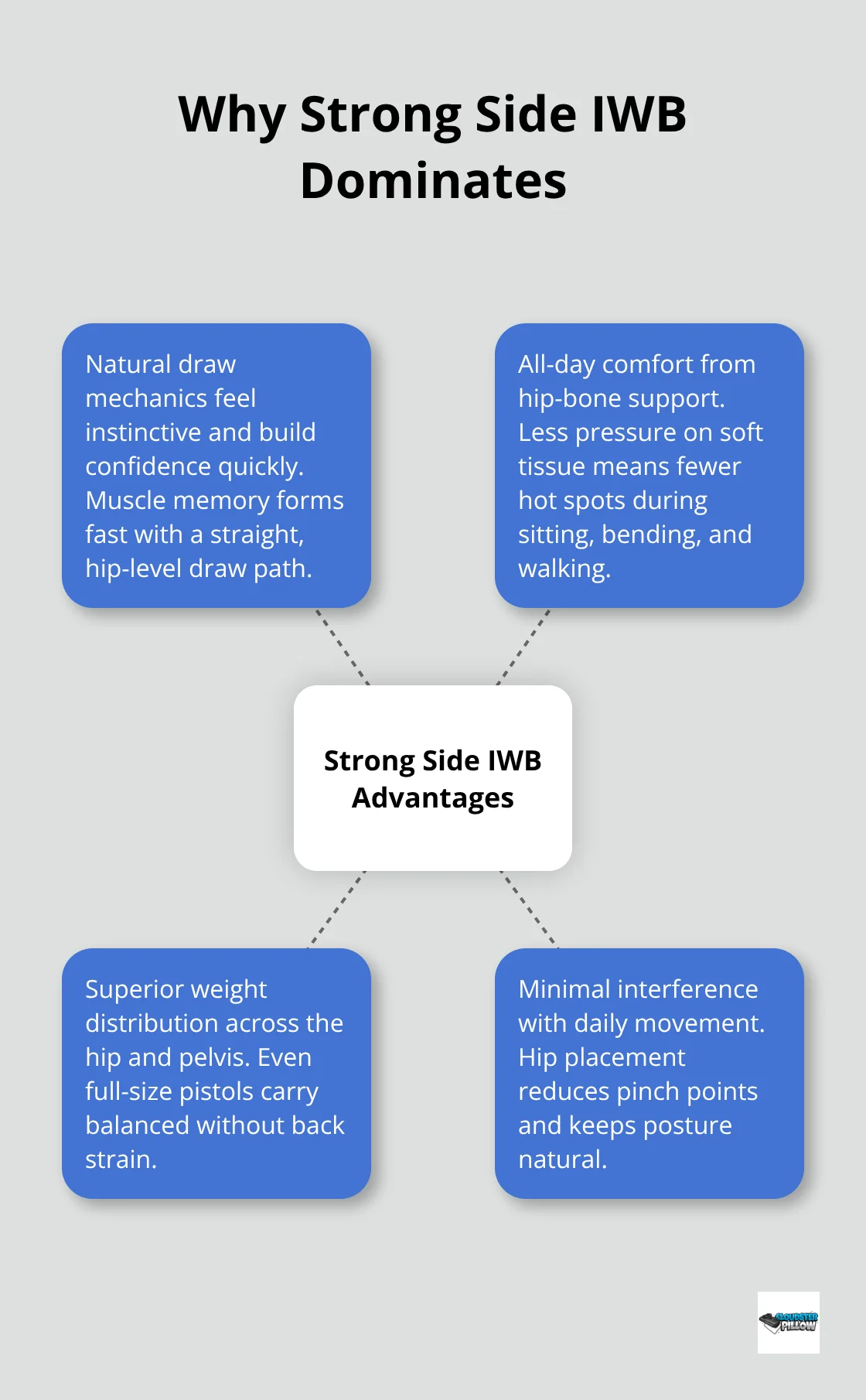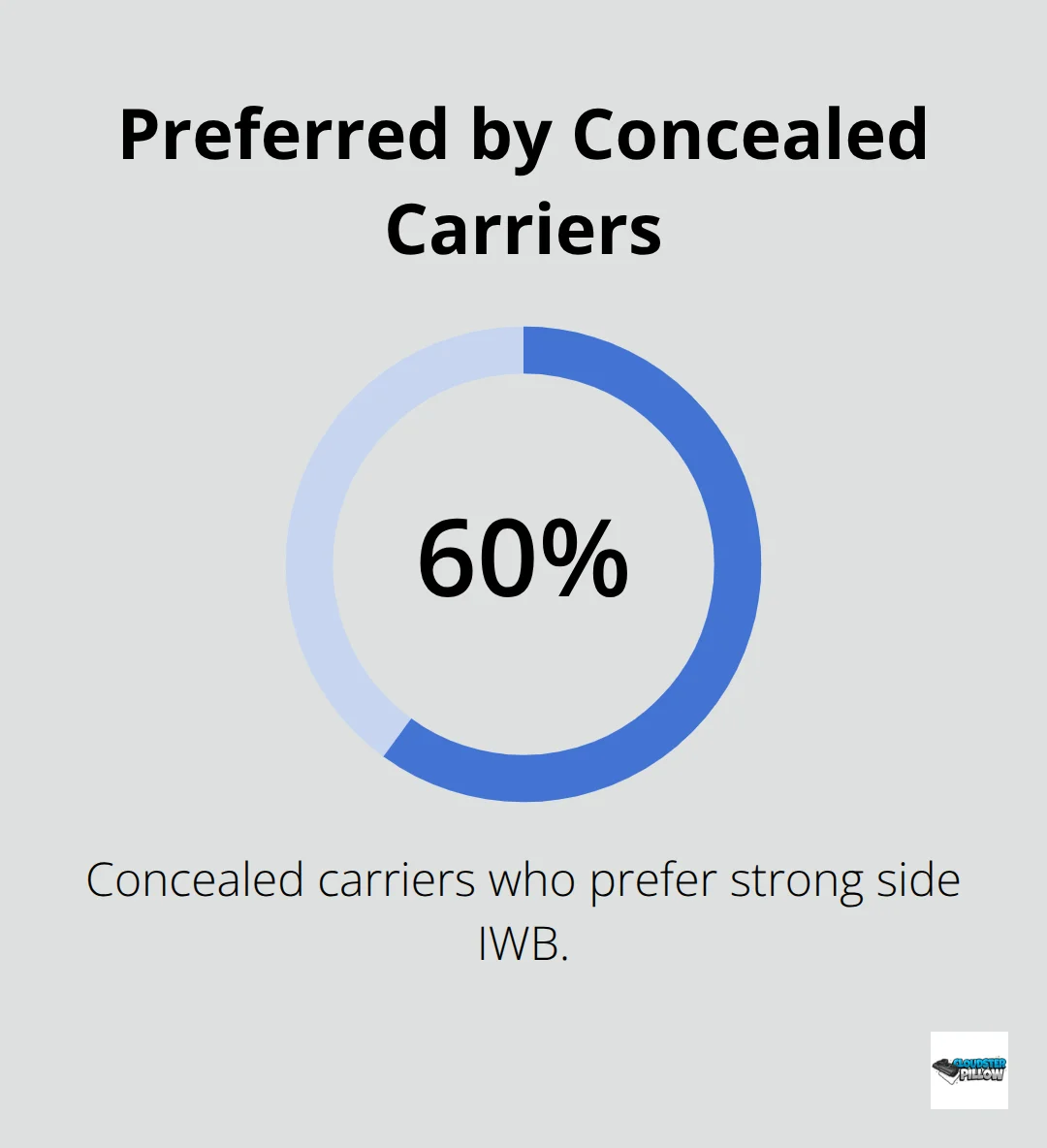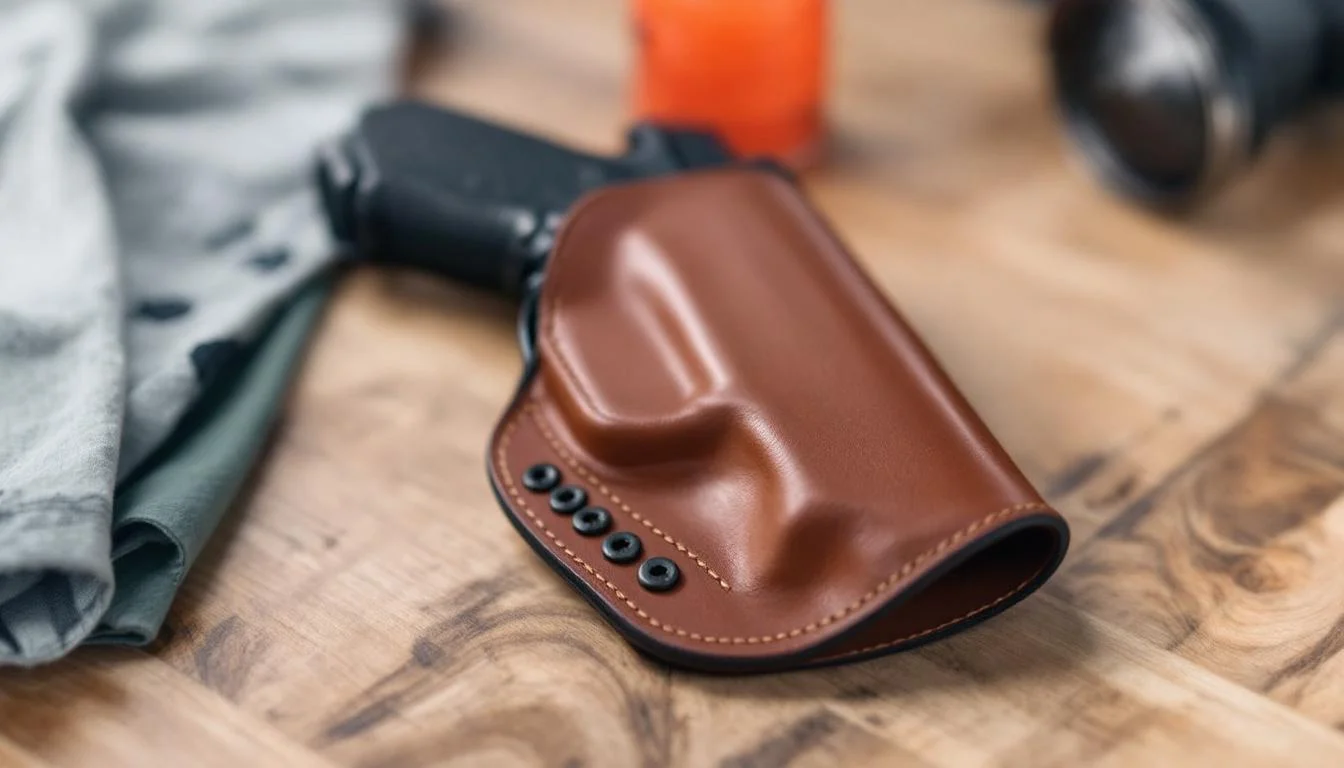Carry Techniques and Optimization
Strong Side IWB Carry Pros and Cons [Complete Analysis]
Strong side IWB carry remains the most popular concealed carry position among experienced carriers. This traditional 3-4 o’clock placement offers natural draw mechanics that feel intuitive to most shooters.
We at Cloudster Pillow see countless carriers choosing this position for daily concealment. However, strong side carry comes with specific trade-offs that every CCW holder should understand before committing to this setup.
Why Strong Side IWB Dominates Carry Positions
Natural Draw Mechanics Build Confidence
Strong side IWB carry creates the most natural draw stroke your body can perform. Your dominant hand moves straight down to your hip, then up and forward – exactly how your arm wants to move. This position builds muscle memory faster than any other carry method. Many concealed carriers prefer this position because it feels instinctive from day one. Your hand finds the grip without conscious thought after just weeks of practice. The draw angle matches your natural arm swing, which reduces training time compared to appendix carry methods.
Extended Comfort That Actually Works
Strong side carry distributes firearm weight across your hip bone rather than pressing into soft tissue. This placement eliminates the dig and pinch that plague other carry positions. Many carriers who use strong side IWB report excellent comfort during extended daily carry. The position works with your body’s natural weight distribution. Your belt supports the gun’s weight without creating pressure points. Most carriers forget they’re armed after the first month. The hip placement also prevents the firearm from interfering with sitting, bending, or normal movement patterns that cause discomfort in other positions.
Superior Weight Distribution Prevents Fatigue
Strong side placement leverages your body’s strongest support structure – the hip and pelvis. This position spreads weight across bone rather than muscle, which prevents the back strain common with other carry methods. Heavier firearms like full-size pistols become manageable for all-day carry.

The weight sits naturally where your body expects it (similar to carrying keys or a phone on your belt). This distribution reduces fatigue compared to appendix carry. Your posture remains natural, and the firearm becomes part of your body’s balanced load distribution system.
However, strong side carry isn’t perfect. Several significant drawbacks can impact your concealment success and daily comfort.
What Are Strong Side IWB’s Major Drawbacks?
Printing Becomes Your Biggest Enemy
Strong side IWB carry creates significant printing challenges that appendix carry simply doesn’t face. When you bend forward, squat, or reach for items, the grip pushes outward against your shirt. This creates an obvious gun-shaped outline that screams concealed carry to anyone who pays attention. Many carriers abandon strong side carry specifically due to printing concerns.
Your shirt rides up during normal movement and exposes both the holster and firearm grip. Tight-fitting clothing makes this position nearly impossible to conceal effectively. Even loose shirts can cling to the grip during windy conditions or when you lean against surfaces. The grip angle naturally pushes fabric away from your body, which creates telltale bulges that experienced eyes spot immediately.

Draw Speed Lags Behind Modern Standards
Strong side IWB consistently produces slower draw times compared to appendix carry positions. The extra distance your hand travels (down to your hip, then up and forward) adds critical milliseconds to your response time. Appendix carry does tend to enhance concealment and inspire a faster draw compared to strong side positions.
Your support hand must also travel further to establish a proper two-handed grip. Vehicle draws become particularly problematic, as seatbelts and confined spaces severely limit access to your strong side. The position also requires more body movement to clear garments, which telegraphs your intentions to potential threats.
Clothing Limitations Restrict Your Wardrobe
Strong side carry demands specific clothing choices that many carriers find restrictive. Fitted shirts, tailored jackets, and form-fitting clothing become off-limits due to printing issues. You need longer shirt tails to cover the entire holster and grip, which limits professional attire options.
Tucked shirts require special holsters and techniques that complicate the draw stroke. Summer clothing presents the biggest challenge, as lightweight fabrics cling to the firearm shape. Business casual and formal wear often become impossible without significant wardrobe modifications that draw attention to your carry setup.
These drawbacks don’t make strong side carry worthless, but they do highlight why many carriers explore alternative positions. Let’s examine how strong side stacks up against other popular carry methods.
How Does Strong Side Compare to Other Positions
Comfort Reality Check
Strong side IWB wins the comfort battle against appendix carry for most body types. The National Shooting Sports Foundation provides comprehensive firearm statistics, with strong side domination due to comfort advantages. Your hip bone naturally supports firearm weight without the pressure points that plague appendix carry.
The firearm sits behind your body rather than presses into soft tissue. Extended drives remain comfortable because you avoid the abdomen and groin pressure that appendix carry creates. Most carriers who switch from appendix to strong side cite comfort as their primary reason.
Appendix carry forces the gun against your stomach and groin area, which creates discomfort over long periods. Strong side eliminates this issue completely (your hip handles the weight distribution naturally).
Speed and Access Differences
Appendix carry delivers faster draw times compared to strong side positions. The draw from waist with holster positioning affects speed significantly. Your support hand reaches the grip faster, and vehicle access becomes significantly easier.
Strong side requires more hand travel distance – down to your hip, then up and forward. This extra movement adds critical milliseconds to your response time. Vehicle draws present particular challenges as seatbelts and confined spaces limit access to your strong side.
However, strong side offers better retention security since the firearm positions away from potential attacks. The US Concealed Carry Association provides guidance on concealed carry positions, noting that appendix carry requires more training to master safely, while strong side feels natural immediately.
Concealment Performance Analysis
Appendix carry provides superior concealment during movement compared to strong side positions. The firearm sits closer to your body’s centerline, which reduces print when you bend or reach. Strong side creates obvious outlines when you squat or lean forward (the grip pushes against your shirt).
Reholster proves safer with strong side carry because you maintain visual contact with the holster throughout the process. Most experienced carriers choose based on their daily activities – office workers often prefer appendix for concealment, while active professionals choose strong side for comfort and security.
Strong side also prevents accidental exposure during normal movement patterns that can reveal appendix-carried firearms.
Final Thoughts
Strong side IWB carry delivers unmatched comfort and natural draw mechanics that make it the preferred choice for 60% of concealed carriers. The position leverages your body’s strongest support structure while it builds muscle memory faster than any alternative method. However, print challenges and slower draw times compared to appendix carry create real limitations that affect daily concealment success.

Success with strong side carry requires strategic clothes choices and quality gear selection. You must invest in a proper gun belt that supports holster weight, choose heavier fabrics that resist print, and practice your draw stroke until it becomes automatic. Regular dry fire training builds the muscle memory that makes this position shine (especially during high-stress situations).
Comfort remains the biggest advantage of strong side carry, but even this position benefits from optimization. The Cloudster Pillow holster wedge enhances concealment and eliminates pressure points that can develop during extended carry. This simple addition transforms good strong side carry into exceptional all-day comfort that keeps you focused on readiness rather than discomfort.


